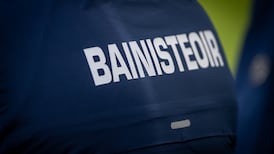At a time when the air is thick with international sport, big rugby and soccer internationals and the launch of Ireland’s RWC bid for 2023, there is an understandable focus on how the GAA keeps itself afloat in the choppy waters of other games competing for players, spectators and public interest
GAA director general Páraic Duffy’s proposal to stage additional fixtures the summer after next is being currently debated and holds out the twin prospects of expanding the top-end football championship schedule and with it, gate receipts and media revenues, and wrapping up the All-Ireland championship by the end of August.
Further consideration of the proposals can safely wait until the decision making processes are more advanced.
But it’s worth reflecting on one concern: the idea that bringing the conclusion of the football championship forward to August leaves the GAA with virtually no media coverage at a time of year when the rugby and soccer seasons are getting under way.
Duffy himself has admitted changing his mind on the issue and now believes that the crisis in club fixtures requires some give in the inter-county season.
A more radical question is whether it matters or not which weeks in September are vacated by Gaelic games.
By that stage the competing sports are well into their stride and interest is unaffected by the sporadic All-Ireland activity.
Reduced unwillingly to the status of an onlooker during this year’s championship climax I couldn’t help noticing that, in the week of the hurling final, the Tipp-Kilkenny match struggled a bit for attention with all of the other activity taking place.
On reflection perhaps the problem with the All-Irelands in September is that the season is too drawn out. No matter how big a sports event is it has a window of only a few days in which it can dominate sports coverage and that’s between build-up, taking place and aftermath.
Concentration spans
Even in the old days when counties were happy to co-operate in providing endless interview material, coverage of an All-Ireland could be stretched to a week at most.
Nowadays that’s far too leisurely a roll-out for media concentration spans in the digital age and even though we all try to provide enough elements to pad out a week, padding is essentially what it is with individual interviews largely a thing of the past and unchanging cast lists at the top of both hurling and football.
The point is that the mere siting of finals in September doesn’t guarantee that everyone’s talking about them for the month.
Think for instance how agog with hurling the country was after the second weekend in August in the immediate aftermath of the Kilkenny-Waterford replay and Tipp-Galway semi-finals.
The mood would have been perfect for the final to be played almost immediately and certainly within two rather than three weeks.
It’s sustained activity that creates interest more effectively than ring fencing events weeks in advance and expecting anticipation to look after itself.
The GAA is already aware of this, as the revised championship structures over the past 20 years have transformed the landscape.
Even with the decline in attendances over the past 10 years it’s worth remembering that the introduction of the quarter-finals and qualifiers to feed them has given the GAA a busy programme in August, which has become a prime example of how fast-moving fixtures’ schedules create interest.
For random example, 25 years ago – which was an historic season in football with Down breaking the 23-year old Munster-Leinster duopoly – the All-Ireland football and hurling series attracted 268,388 spectators.
Last summer the same months of August and September drew 75 per cent more than that, 470,744 (not counting the replays in either the All-Ireland football final or the hurling semi-final) and the match averages were also higher.
That suggests a lot more interest and activity without taking into account July’s football and hurling quarter-finals.
Confident display
There is a further argument, which is that GAA coverage actually doesn’t dip alarmingly in the autumn and winter. County and club championships mightn’t have the same national appeal but they provide something that the inter-county equivalent has struggled to in recent years: competitiveness.
Last weekend is an excellent example.
The Nire won the Waterford football championship this year and on Sunday defeated Cork champions Carbery Rangers in Clonakilty in a confident display that saw them overcame a difficult start and then outlast the favourites in extra-time.
That was just the latest in what has been a fine sequence of performances by the county’s football clubs in the past 13 years during which time Waterford champions have reached the provincial final on five occasions, albeit without winning the title.
Such a record of competitiveness has been beyond the county, which hasn’t been in a Munster football final since 1960.
Next weekend the champions of Cork and Clare meet in the hurling final, both with axes to grind. Clare haven’t won an inter-county senior championship match since 2013 whereas Cork have one title in 10 years.
The national stage in Gaelic games might be bare but there’s plenty going on in the wings. All GAA is local.











